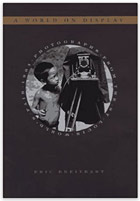 Full-Court Quest: The Girls from Fort Shaw Indian School, Basketball Champions of the World
Full-Court Quest: The Girls from Fort Shaw Indian School, Basketball Champions of the World
Most fans of women’s basketball would be startled to learn that girls’ teams were making their mark more than a century ago—and that none was more prominent than a team from an isolated Indian boarding school in Montana. Playing like “lambent flames” across the polished floors of dance halls, armories, and gymnasiums, the girls from Fort Shaw stormed the state to emerge as Montana’s first basketball champions.
Taking their game to the 1904 St. Louis World’s Fair, these young women introduced an international audience to the fledgling game and returned home with a trophy declaring them champions. Champions of the World!
 Meet Me in St. Louis: A Trip to the 1904 World's Fair
Meet Me in St. Louis: A Trip to the 1904 World's Fair
You are holding a ticket to one of the largest and most magnificent celebrations of all time -- the 1904 St. Louis World's Fair!
For seven months nearly twenty million visitors from around the globe flooded the fairgrounds of Forest Park. Many explored the twelve mammoth palaces (made of plaster and horsehair!), which showcased amazing exhibits. Others enjoyed watching the first Olympic Games in the United States, keeping cool all summer with a new treat that became an instant hit -- the ice-cream cone. And everyone loved viewing all 1275 acres of fairgrounds from atop the 265-foot Ferris wheel.
 Still Shining! Discovering Lost Treasures from the 1904 St. Louis World's Fair
Still Shining! Discovering Lost Treasures from the 1904 St. Louis World's Fair
In Still Shining!, Diane Rademacher tracks down the present history and location of the 1904 World's Fair most beloved buildings and structures. Rademacher's book contains original pictures of famous structures and how they look today.
 1904 St. Louis World’s Fair: The Louisiana Purchase Exposition in Photographs
1904 St. Louis World’s Fair: The Louisiana Purchase Exposition in Photographs
More than 360 pages of images! Experience the 1904 St. Louis World’s Fair in incredible detail.
1904 St. Louis World’s Fair: The Louisiana Purchase Exposition in Photographs transports readers into a bygone era filled with wonders on an incredible scale that is unimaginable today. Hundreds of period photographs, drawings, and maps illustrate one of America’s most important forgotten events, The Louisiana Purchase Exposition.
 St. Louis: The 1904 World's Fair (Images of America: Missouri)
St. Louis: The 1904 World's Fair (Images of America: Missouri)
For seven months in 1904, St. Louis was the greatest city on earth. Millions flocked to the Louisiana Purchase Exposition to behold the inventions of the early 20th century.
St. Louis: The 1904 World's Fair tells the story of the greatest Victorian-era world’s fair since the lights of the fair faded over a century ago, while also examining the fair’s legacies and legends.
 1904 World's Fair: The Filipino Experience
1904 World's Fair: The Filipino Experience
An impressive, thoroughly researched book, revealing for the first time the sad experience of the native Filipinos at the 1904 World's Fair, and in the expositions before and after it.
 Anthropology Goes to the Fair: The 1904 Louisiana Purchase Exposition
Anthropology Goes to the Fair: The 1904 Louisiana Purchase Exposition
World’s fairs and industrial expositions constituted a phenomenally successful popular culture movement during the nineteenth and twentieth centuries. In addition to the newest technological innovations, each exposition showcased indigenous peoples from the colonial empires of the host country.
As scientists claiming specialized knowledge about indigenous peoples, especially American Indians, anthropologists used expositions to promote their quest for professional status and authority.
 A World on Display: Photographs from the St. Louis World's Fair, 1904
A World on Display: Photographs from the St. Louis World's Fair, 1904
The Fair's organizers brought some 2,000 native people to St. Louis to take part in the most extensive anthropological exhibits ever assembled for a world's fair. The author has assembled seventy-five photographs of these "living exhibits" and explores what the photographs represented when they were made, how they were used and what significance they hold for viewers today.
 Savage to Civilized: The Imperial Agenda on Display at the St. Louis World Fair of 1904
Savage to Civilized: The Imperial Agenda on Display at the St. Louis World Fair of 1904
To hold an international exposition in the late 19th and early 20th centuries meant that a nation was wanting to secure a place among the most powerful and developed nations of the world.
In order to present itself as an advanced civilization, the United States used events like its world fairs as opportunities to show off its progress and domination.
In this age of imperialism, the best way for a country to accomplish this was for it to create exhibits depicting the "savage" nature of other lesser developed nations. Social Darwinism and scientific racism were rampant in an attempt to legitimize the colonial policies of the time period and demonstrate the greatness of Western powers.The Louisiana Exposition of 1904 is the best example of this ideology as seen in the United States.
Under the preface of "educational exhibits" and "studies in the field of man," these anthropological displays not only showed that the United States was amongst the most advanced civilizations of the world, but they also validated Western involvement in these nations as a means to rescue them from barbarism.



